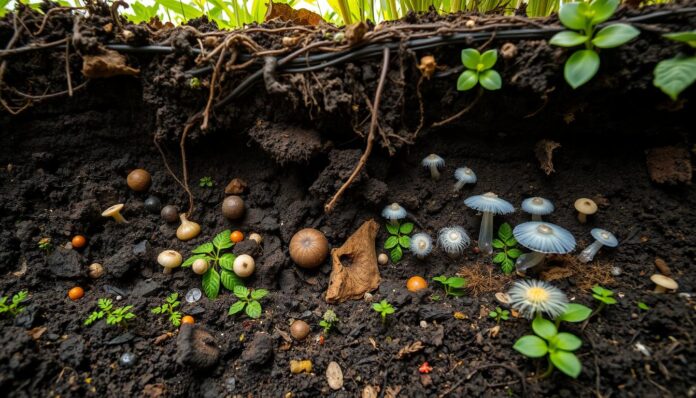What if the key to a sustainable future is in the ground? Our soil’s health is key for food, balance, and the environment. Permaculture’s soil microbes are crucial for soil health. They help us move away from harmful farming methods.
As more people seek soil restoration, it’s clear we want better ways to improve soil. Permaculture systems offer a sustainable path. They focus on making systems that heal and grow.
By focusing on soil health and microbes, we can create a better ecosystem. But how do we regenerate our soil for a sustainable future?
Key Takeaways
- Soil health is essential for food production and ecological balance
- Permaculture soil microorganisms play a crucial role in soil health
- Conventional agricultural practices can deplete soil health
- Permaculture systems offer a sustainable and regenerative alternative
- Understanding soil composition and the role of microorganisms is vital for effective soil regeneration
- Implementing permaculture principles can help improve soil health and promote a healthier ecosystem
- Soil regeneration is critical for environmental quality and human health
Introduction to Permaculture Soil Regeneration
Permaculture soil regeneration is a way to make the soil healthy by creating a balanced ecosystem. It focuses on beneficial bacteria and other tiny life forms that keep the soil fertile. By using organic gardening methods, people can help the soil heal and support plant growth.
Healthy topsoil is full of billions of tiny creatures that help break down organic matter and make nutrients available. Cover crops, like legumes, can pull nitrogen from the air and add it to the soil when they break down. This natural method cuts down on the need for chemical fertilizers and helps the soil stay healthy.
- Improved soil structure and nutrient availability
- Increased water retention capacity
- Enhanced biodiversity and ecosystem services
- Reduced reliance on synthetic fertilizers and pesticides
What is Soil Regeneration?
Soil regeneration is about making the soil healthy again using natural and organic gardening methods. It highlights the role of beneficial bacteria and other tiny life forms in keeping the soil fertile and supporting the ecosystem.
Importance of Soil Health in Permaculture
Soil health is key in permaculture because it affects plant growth, biodiversity, and ecosystem services. By using permaculture soil regeneration practices, people can build a sustainable and strong environment. This environment supports soil health and helps keep the ecosystem in balance.
Understanding Soil Composition
Soil is made up of physical, chemical, and biological parts. A healthy soil is key for regenerative agriculture. It helps plants grow and supports microorganisms.
The soil’s health comes from organic matter and microorganisms like bacteria and fungi. These help the soil stay fertile and hold water. Earthworm castings are rich in nutrients, up to 11 times more than regular soil.
Healthy soil has many benefits, including:
- It helps nutrients cycle and become available to plants
- It keeps the soil’s structure and holds water better
- It makes plants grow stronger and fight off pests and diseases
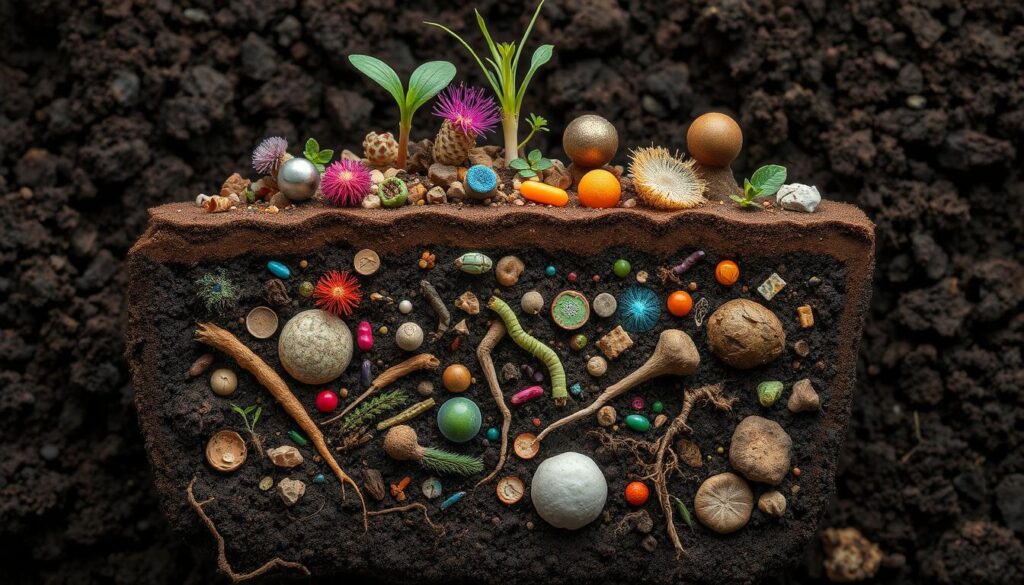
Knowing about soil composition and microorganisms helps farmers and gardeners. They can use regenerative practices to improve soil health. This leads to more sustainable and productive farming.
| Soil Component | Importance |
|---|---|
| Organic Matter | Enables aeration and moisture retention |
| Soil Microorganisms | Contribute to soil fertility and structure |
Principles of Permaculture
Permaculture is a way to design sustainable living systems. It focuses on three main ethics: earth care, people care, and fair share. These ethics help guide the setup and care of permaculture systems, from small gardens to big farms.
The design of permaculture is all about learning from nature. By copying natural patterns, designers create systems that work better, produce more, and are stronger. Sustainable farming practices, like composting, are key to keeping soil healthy and ecosystems balanced.
Three Ethics of Permaculture
- Earth care: caring for the natural environment and preserving its resources
- People care: caring for the well-being and dignity of all individuals
- Fair share: sharing resources and benefits in a fair and equitable manner
Design Principles for Sustainability
Permaculture design is all about sustainability. It uses renewable resources, cuts down on waste, and boosts biodiversity. This way, permaculture systems can be more sustainable and regenerative.
sustainable farming practices, such as composting and organic waste management.
The Cycle of Soil Regeneration
Soil regeneration is key in permaculture. It breaks down organic matter and builds a healthy soil ecosystem. This cycle keeps soil ecology strong and supports the growth of beneficial microorganisms. A study onsoil ecology and permaculture shows adding organic waste is vital for regenerative farming.
How Regeneration Works
Soil regeneration starts with adding organic matter like compost or mulch. This supports the growth of important microorganisms. These microbes help break down organic matter and release nutrients.
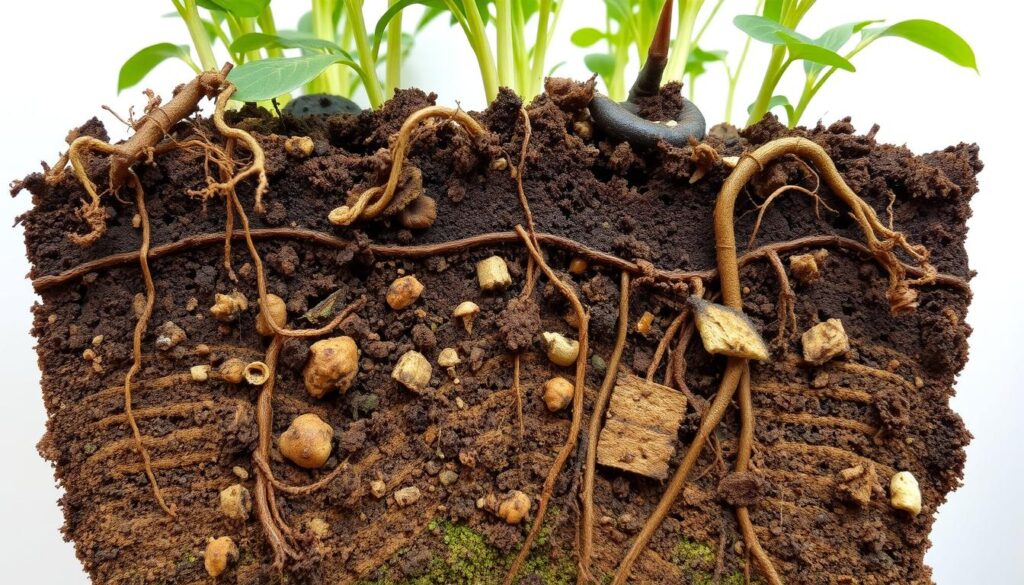
As organic matter breaks down, it improves soil structure and biodiversity. It also makes nutrients more available.
Benefits of a Regenerative Cycle
A regenerative cycle offers many benefits. It improves soil fertility and boosts crop yields. It also enhances ecosystem services. By supporting soil ecology and microorganisms, farmers can create sustainable food systems.
Some key benefits include:
- Improved soil structure and fertility
- Increased biodiversity and ecosystem services
- Enhanced nutrient availability and crop yields
- Reduced soil erosion and improved water quality
By using regenerative practices, farmers can fight climate change and improve soil health. Soil regeneration is crucial for a sustainable agricultural future.
Techniques for Soil Regeneration
Soil health is key for sustainable farming. Many methods can help achieve this. Cover cropping is one, where crops are planted between main crops. This reduces soil erosion and boosts beneficial bacteria.
Mulching is another method. It keeps soil moist, cutting down on watering needs. Mulch needs to be added several times a year as it gets absorbed fast. Wood chips, for example, can turn hard clay into fertile garden beds.
Using composts and organic matter also improves soil health. They help beneficial bacteria and make soil hold more water. This means less watering and more crops. Healthy soils can make crops 20-100% more productive.
- Cover cropping can reduce soil erosion by over 90%.
- Mulching can help retain moisture in the soil, reducing the need for frequent watering.
- The addition of organic matter can enhance soil’s water-holding capacity by approximately 20-30%.
By using these methods, farmers can make their soil healthier. This reduces the need for fertilizers and boosts beneficial bacteria. It leads to more sustainable and productive farming.
Building a Healthy Soil Ecosystem
Creating a thriving soil ecosystem is key for organic gardening and regenerative agriculture. It’s about boosting soil biodiversity and encouraging healthy microbes. By doing so, gardeners can make the soil more fertile, structured, and healthy.
Soil biodiversity is vital for a healthy ecosystem. It lets different microorganisms live and work together. This can be done by using compost, cover crops, and crop rotation. For instance, legumes can boost soil nitrogen, and compost adds nutrients and microbes.
Enhancing Soil Biodiversity
Here are some ways to boost soil biodiversity:
- Using compost to introduce beneficial microorganisms
- Planting cover crops to increase soil organic matter
- Implementing crop rotation to disrupt pest cycles
Promoting Healthy Microbial Activity
Healthy microbes are crucial for soil health. Organic gardening practices like minimal tilling and adding organic matter help. For example, 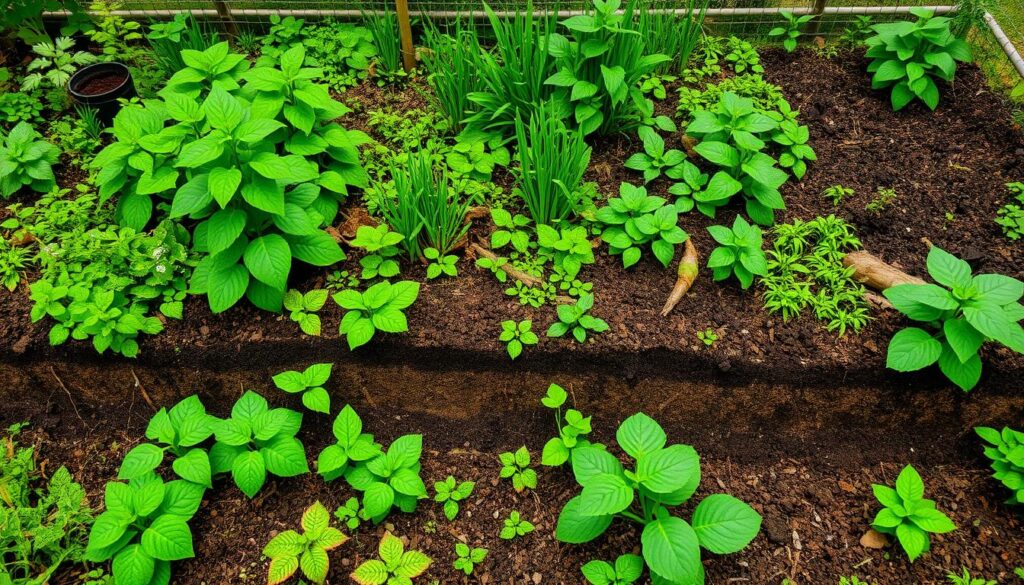 perennial plants can raise soil organic matter by 2-4% yearly, helping microbes thrive.
perennial plants can raise soil organic matter by 2-4% yearly, helping microbes thrive.
By using these methods, gardeners can build a healthy soil ecosystem. This supports regenerative agriculture and organic gardening. It leads to better soil, higher crop yields, and a more sustainable food system.
Assessing Soil Health
To check your soil’s health, you need to look at its microbiome. A good soil microbiome is key for farming that lasts. It helps plants grow and keeps the ecosystem in balance. You can tell soil health by the fungi to bacteria (F:B) ratio.
In bare land, the F:B ratio is mostly bacteria. But in weedy areas, it’s very low. Deciduous trees have a ratio that can range from 5.0 to 100. Knowing these ratios helps farmers balance their soil microbiome for sustainable farming.
A study on permaculture practices showed permaculture sites have 27% more soil carbon than control fields. This shows why sustainable farming is vital for soil health. Soil health is also shown by its structure, organic matter, and microbial activity.
By using these signs and ratios, farmers can check their soil’s health. They can then decide how to make it better. This might mean adding organic matter, using cover crops, or reducing tillage. By focusing on soil health and using green farming methods, farmers can make their ecosystems more balanced and productive.
| Land Use | F:B Ratio |
|---|---|
| Bare Land | 100% bacterial |
| Weedy Areas | 0.1 |
| Deciduous Trees | 5.0-100 |
Implementing Soil Regeneration in Your Garden
To start soil regeneration in your garden, learn about composting and soil ecology. Composting turns organic waste into a nutrient-rich soil amendment. Soil ecology studies how soil organisms interact with their environment. This knowledge helps create a balanced garden ecosystem.
A good soil regeneration plan boosts soil fertility and crop yields. It also makes your garden more resilient. Key techniques include:
- Adding organic matter like compost or manure
- Using cover crops to protect soil and improve health
- Practicing conservation tillage or no-till to reduce soil damage
Consider your garden’s specific needs when choosing techniques. For example, heavy clay soil might need more organic matter for better drainage. A holistic approach to soil regeneration leads to a sustainable garden.
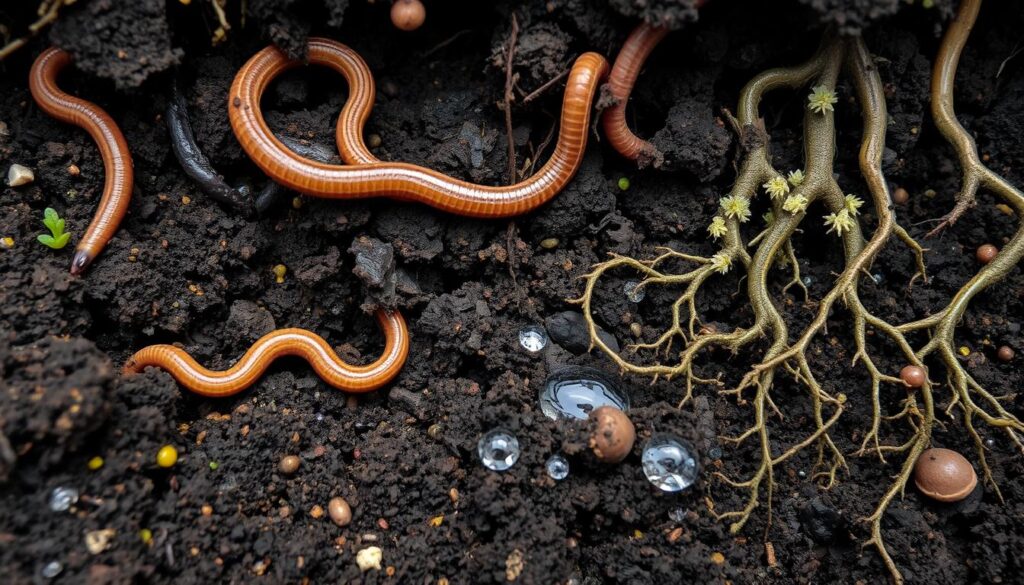
Start using these steps and tailor them to your garden’s needs. Remember, composting and soil ecology are crucial for a healthy garden. They offer many benefits for your garden’s ecosystem.
Long-term Soil Management Strategies
Keeping soil healthy is key for permaculture. This means using crop rotation and diversity, and caring for the soil seasonally. These steps help improve soil, reduce erosion, and make farming more sustainable.
Some important strategies for managing soil include:
- Using no-till or reduced-till farming to avoid soil damage and help roots grow
- Keeping the soil covered with plants to stop water runoff and boost life in the soil
- Practicing controlled grazing to add nutrients back into the soil
- Limiting synthetic chemicals to let nature’s processes work
These methods help improve soil health, boost crop yields, and lessen environmental harm. Healthy soil is vital for sustainable farming. By focusing on soil health, we build a stronger and more productive food system.
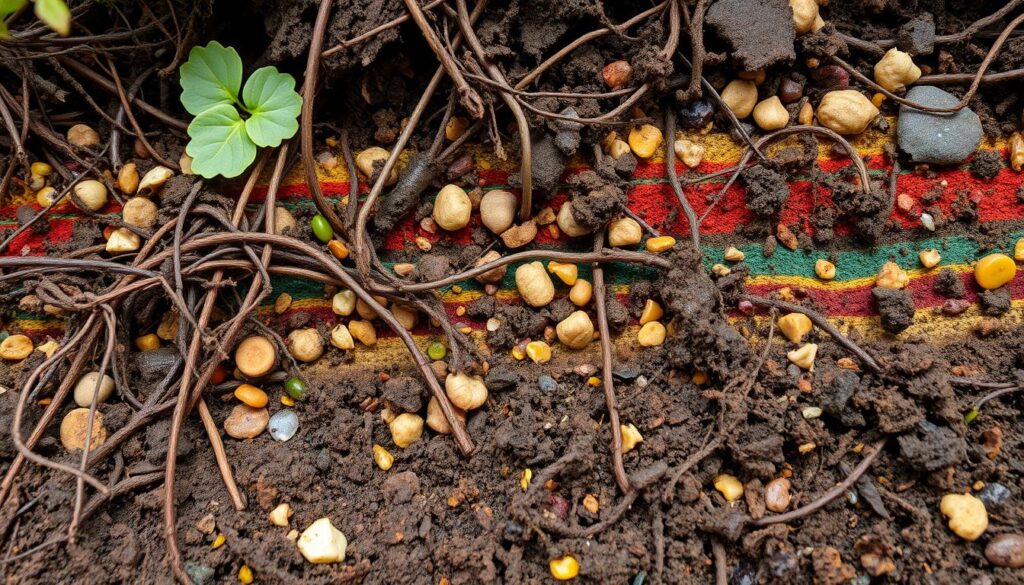
Permaculture also plays a big role in soil health. It encourages biodiversity, fights erosion, and makes soil more fertile. By working with nature, we can build a more sustainable and regenerative food system.
| Soil Management Strategy | Benefits |
|---|---|
| Crop Rotation and Diversity | Improved soil fertility, reduced erosion, increased biodiversity |
| Seasonal Care Practices | Reduced soil compaction, promoted root growth, increased biological activity |
Case Studies of Successful Soil Regeneration
Soil regeneration might seem simple, but it takes real-world experience to get it right. By looking at thriving permaculture farms, we learn effective strategies. These methods help restore soil health and balance ecosystems.
Bec Hellouin Farm: Maximizing Yield in a Small Footprint
The Bec Hellouin Farm in France shows the power of regenerative agriculture. Despite being only 0.9 acres, it produces ten times more than big organic farms. It sends up to 100 vegetable boxes a week to locals and fancy restaurants.
The farm’s success comes from its diverse, healthy soil. It uses cover crops, composting, and little tillage. This approach builds a strong soil ecosystem.
Transforming Contaminated Soils through Phytoremediation
Permaculture uses special plants to clean polluted soils. In Western Europe, over 300,000 sites are polluted. Plants like sunflowers and Chinese brake ferns clean up heavy metals.
In the USA, 600,000 brownfield sites also benefit from these plants. They absorb harmful substances like lead and arsenic.
Learning from these farms, we can create a better future. We can make our soils and ecosystems healthier and more sustainable.

